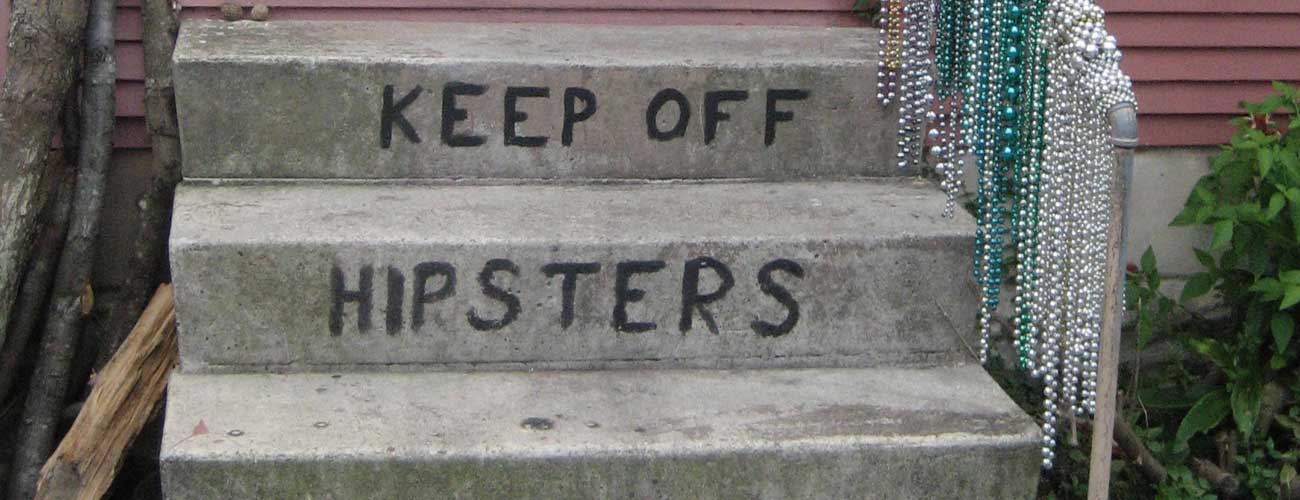Sign up for the daily CJR newsletter.
We are in the midst of a Hipster Glut, the nation’s leading newspapers report. This sprawling cohort has overrun Montauk on Long Island, according to The New York Times. The Washington Post believes they are living in downtown high-rises. The Wall Street Journal reports that a suburban office park developer intends to lure them to New Jersey with a sufficiently “cool” new development.
Call me cranky but most of those Hamptons party-goers are not “hipsters.” A few might dress the part, but most find more comfort in a pair of khaki shorts and a polo shirt. They are young and rich, but have little in common with an unalloyed hipster. As for downtown Washington’s new denizens, well, it’s not clear why any right-minded hipster would be living in a highrise.
The word hipster is supposed to refer to a specific subset of people. News outlets are instead just using it as shorthand for anyone who is under 40, has a college degree, and lives in or near a major city. This expansive categorization means the media calls people hipsters who are the antithesis of that term–clean-cut bankers on Manhattan’s Upper East Side, for example.
Here are some signs of actual hipsters:
- Within the universe of the young, moderately affluent and educated, they are the arty, trailblazing alternative to the square or conventional.
- Telltale markers might include a beard or the approximation of one, boots with skirts on women, faded flannel shirts, abundant tattoos, and square-framed glasses.
- The hipster’s native habitat is a reclaimed wooden bench next to a food truck serving farm-to-table anything.
- Ellen Page is a hipster, Britney Spears is not.
The knock on hipsters is that they pretend to be poor and adopt working-class affectations: dressing like a lumberjack, drinking revolting beers, moving into an abandoned factory in a poor neighborhood. So when the Post leads a story with a reference to “The stereotype of hipster millennials living in downtown high-rise condos,” they are making no sense. The stereotype of the people who live in those buildings is yuppies and tech bros. The stereotype of a hipster is that she reviles the generic style of luxurious new buildings that intrude on her gentrifying neighborhood. The Times weirdly complains that “the hipster is … importing [to Montauk] … a new attitude that says, ‘I’m richer than you.’ ” It contrasts this with Montauk’s identity as a place where you couldn’t tell the shabbily dressed millionaires from a vagrant. This is the point at which a writer or editor should realize “hipster” isn’t the right word for the button-down Manhattanites and heavily made-up Long Islanders who hit the bars in Montauk. (Visit one of those bars and then an actual hipster bar in Brooklyn’s Bushwick and you’ll understand the difference.)
The rise in the word “hipster” from 1900 to 2008
The habit of invoking hipsters too often isn’t new, but it’s only advancing. Times Standards Editor Philip B. Corbett chastised his paper for overusing the word “hipster” back in 2010, noting it had appeared in the paper over 250 times in the previous year. “With so many appearances, I’m not sure how precise a meaning it conveys,” Corbett notes. Putting “hipster” into the Times‘ search engine this week returned 288 results from the last 12 months. (Some are in quotes.)
For what it’s worth, I’m 33 and I was never remotely hip, so perhaps the references in this article are outdated. But I am alert enough to smell something fishy, and careful enough to ask my more knowledgeable friends when to call a hipster a hipster. The media should be, too.
Has America ever needed a media defender more than now? Help us by joining CJR today.







